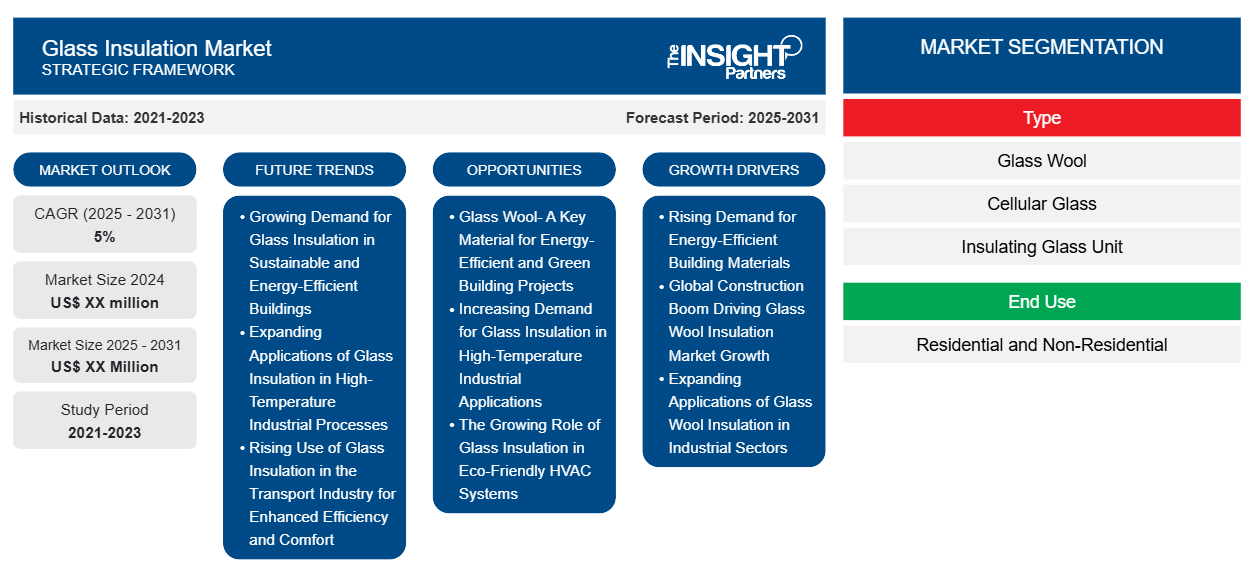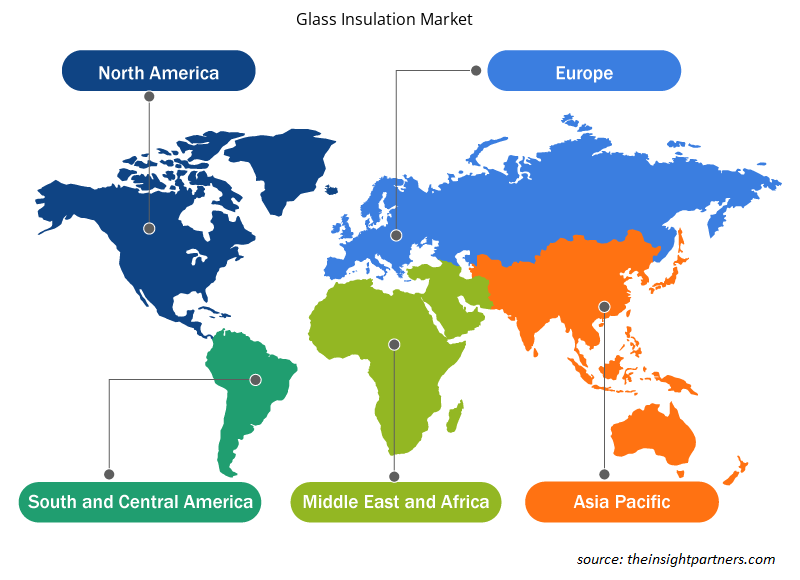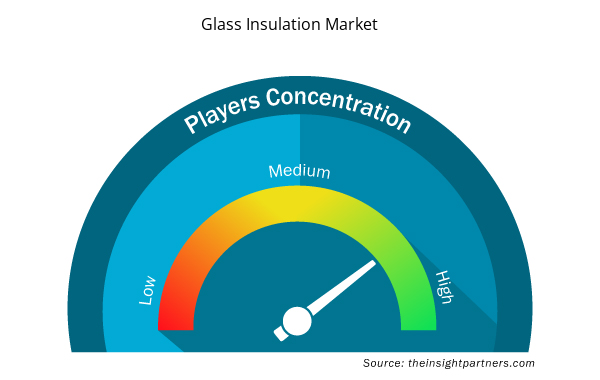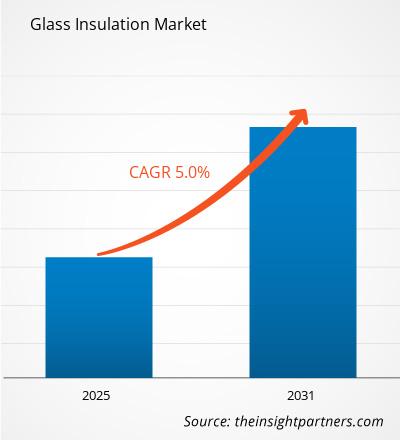Se espera que el mercado de aislamiento de vidrio registre una CAGR del 5% entre 2025 y 2031, con un tamaño de mercado que se expandirá de US$ XX millones en 2024 a US$ XX millones en 2031.
El informe está segmentado por tipo (lana de vidrio, vidrio celular y unidad de vidrio aislante). El análisis global se desglosa a nivel regional y por países principales. El informe también presenta un análisis basado en el uso final (residencial y no residencial). El análisis global se desglosa a nivel regional y por países principales. El alcance del informe abarca el tamaño y las previsiones del mercado a nivel global, regional y nacional para todos los segmentos clave del mercado. El informe ofrece el valor en USD para el análisis y los segmentos mencionados. El informe proporciona estadísticas clave sobre el estado del mercado de los principales actores y presenta tendencias y oportunidades del mercado.
Propósito del Informe
El informe "Mercado de Aislamiento de Vidrio" de The Insight Partners busca describir el panorama actual y el crecimiento futuro, los principales factores impulsores, los desafíos y las oportunidades. Esto proporcionará información a diversos actores del sector, como:
- Proveedores/Fabricantes de Tecnología: Para comprender la dinámica cambiante del mercado y conocer las oportunidades potenciales de crecimiento, lo que les permitirá tomar decisiones estratégicas informadas.
- Inversores: Realizar un análisis exhaustivo de tendencias respecto a la tasa de crecimiento del mercado, las proyecciones financieras del mercado y las oportunidades que existen en toda la cadena de valor.
- Organismos reguladores: Regular las políticas y las actividades policiales en el mercado con el objetivo de minimizar el abuso, preservar la confianza de los inversores y defender la integridad y estabilidad del mercado.
Segmentación del mercado de aislamiento de vidrio
Tipo
- Lana de vidrio
- Vidrio celular
- Unidad de vidrio aislante
Uso final
- Residencial y no residencial
Personalice este informe según sus necesidades
Obtendrá personalización en cualquier informe, sin cargo, incluidas partes de este informe o análisis a nivel de país, paquete de datos de Excel, así como también grandes ofertas y descuentos para empresas emergentes y universidades.
Mercado de aislamiento de vidrio: Perspectivas estratégicas

- Obtenga las principales tendencias clave del mercado de este informe.Esta muestra GRATUITA incluirá análisis de datos, desde tendencias del mercado hasta estimaciones y pronósticos.
Factores que impulsan el crecimiento del mercado del aislamiento de vidrio
- Creciente demanda de materiales de construcción energéticamente eficientes: Debido al aumento de los precios de la energía y al cambio climático, existe una creciente necesidad de materiales de construcción que ahorren energía. La lana de vidrio posee propiedades de aislamiento térmico y acústico altamente efectivas, minimizando así el desperdicio de energía en edificios residenciales y comerciales. Con cada vez más economías que mejoran la aplicación de las normas de regulación energética, estos aislamientos adquieren relevancia.insulations get to be of relevance.
- El auge mundial de la construcción impulsa el crecimiento del mercado del aislamiento de lana de vidrio: La inexplicable expansión del mercado del aislamiento de vidrio se atribuye a la expansión de la industria de la construcción a nivel mundial. Debido a la rápida urbanización, se necesitan nuevos edificios residenciales, industriales y comerciales, lo que requiere materiales aislantes. En este sentido, el aislamiento de vidrio facilita la eficiencia energética tanto en nuevas instalaciones como en obras de rehabilitación.
- Aplicaciones en expansión del aislamiento de lana de vidrio en sectores industriales: Además de su uso en hogares y oficinas, el aislamiento de vidrio está ganando popularidad en sectores industriales como la manufactura, la automoción e incluso la petroquímica. Su resistencia al calor y sus límites de operación a altas temperaturas permiten su uso en lugares como el aislamiento de tuberías, cámaras de hornos y sistemas de climatización.
Tendencias futuras del mercado del aislamiento de vidrio
- Creciente demanda de aislamiento de vidrio en edificios sostenibles y energéticamente eficientes: El creciente énfasis en la construcción de estructuras energéticamente eficientes y sostenibles impulsará la demanda de aislamiento de vidrio. A medida que se implementan normas cada vez más estrictas sobre el consumo de energía, el aislamiento de vidrio ofrece un excelente aislamiento térmico y acústico, por lo que también se utiliza ampliamente para ahorrar energía y mejorar el confort y la eficiencia de estructuras residenciales y comerciales.
- Aplicaciones en expansión del aislamiento de vidrio en procesos industriales de alta temperatura: Es probable que el aislamiento de vidrio gane aceptación y uso en procesos industriales como plantas de generación de energía, refinerías de petróleo y procesamiento químico, donde la resistencia a temperaturas extremadamente altas y la seguridad son vitales. Por ejemplo, la lana de vidrio, así como otros sistemas de aislamiento de vidrio, son eficaces en áreas que requieren aislamiento térmico, control de ruido y protección contra incendios.
- Aumento del uso de aislamiento de vidrio en la industria del transporte para mejorar la eficiencia y el confort: Se prevé un crecimiento del sector del aislamiento de vidrio debido al mayor uso de materiales aislantes en la industria del transporte, con el fin de mejorar la eficiencia del combustible y el confort. En concreto, el aislamiento de vidrio se utilizará cada vez más en vehículos como trenes, autobuses y barcos debido a su ligereza, resiliencia y menor pérdida de energía en los sistemas de calefacción y refrigeración.
Oportunidades del mercado del aislamiento de vidrio
- Lana de vidrio: un material clave para proyectos de construcción ecológica y energéticamente eficientes: Dada la creciente preocupación por reducir el consumo energético en la construcción y el funcionamiento de los edificios, la lana de vidrio se beneficiará enormemente. Es un material energéticamente eficiente, ideal para edificios residenciales y comerciales, ya que no solo mejora la eficiencia energética, sino que también proporciona aislamiento térmico y acústico, fundamental para los proyectos de construcción ecológica. Además, la apuesta por diseños de edificios más adaptables propiciará una mayor aceptación del aislamiento de vidrio.
- Creciente demanda de aislamiento de vidrio en aplicaciones industriales de alta temperatura: El aislamiento de vidrio es cada vez más relevante en aplicaciones industriales de alta temperatura, incluyendo, entre otras, plantas de gas, refinerías de petróleo y plantas químicas. Gracias a la capacidad del material para cumplir su función térmica incluso en temperaturas extremas, a la vez que es resistente a cualquier tipo de deterioro, el aislamiento térmico se convierte en una necesidad en la industria pesada, lo que abre un mercado prometedor en este sector.
- El creciente papel del aislamiento de vidrio en los sistemas de climatización ecológicos: El avance de los sistemas de climatización también ha contribuido al aumento de la demanda de aislamiento de vidrio para sistemas de calefacción, ventilación y aire acondicionado, mejorando así la eficiencia energética. La transición hacia sistemas de climatización energéticamente eficientes y ecológicos representa una oportunidad creciente para los fabricantes de aislamiento de vidrio en los mercados residencial y comercial.
Perspectivas regionales del mercado del aislamiento de vidrio
Los analistas de Insight Partners han explicado detalladamente las tendencias y los factores regionales que influyen en el mercado del aislamiento de vidrio durante el período de pronóstico. Esta sección también analiza los segmentos y la geografía del mercado del aislamiento de vidrio en América del Norte, Europa, Asia Pacífico, Oriente Medio y África, y América del Sur y Central.

- Obtenga los datos regionales específicos para el mercado de aislamiento de vidrio
Alcance del informe de mercado de aislamiento de vidrio
| Atributo del informe | Detalles |
|---|---|
| Tamaño del mercado en 2024 | US$ XX millones |
| Tamaño del mercado en 2031 | US$ XX millones |
| CAGR global (2025-2031) | 5% |
| Datos históricos | 2021-2023 |
| Período de pronóstico | 2025-2031 |
| Segmentos cubiertos | Por tipo
|
| Regiones y países cubiertos | América del norte
|
| Líderes del mercado y perfiles de empresas clave |
|
Densidad de actores del mercado de aislamiento de vidrio: comprensión de su impacto en la dinámica empresarial
El mercado del aislamiento de vidrio está en rápido crecimiento, impulsado por la creciente demanda del usuario final debido a factores como la evolución de las preferencias del consumidor, los avances tecnológicos y una mayor conciencia de los beneficios del producto. A medida que aumenta la demanda, las empresas amplían su oferta, innovan para satisfacer las necesidades del consumidor y aprovechan las tendencias emergentes, lo que impulsa aún más el crecimiento del mercado.
La densidad de actores del mercado se refiere a la distribución de empresas o compañías que operan en un mercado o sector en particular. Indica cuántos competidores (actores del mercado) hay en un mercado determinado en relación con su tamaño o valor total.
Las principales empresas que operan en el mercado de aislamiento de vidrio son:
- Compañía Nippon Sheet Glass Ltd.
- Owens Corning
- Industrias PPG, Inc.
- Certain Teed Corporation
Descargo de responsabilidad : Las empresas enumeradas anteriormente no están clasificadas en ningún orden particular.

- Obtenga una descripción general de los principales actores clave del mercado de aislamiento de vidrio
Puntos clave de venta
- Cobertura integral: el informe cubre de manera integral el análisis de productos, servicios, tipos y usuarios finales del mercado de aislamiento de vidrio, proporcionando un panorama holístico.
- Análisis de expertos: el informe se compila con base en el conocimiento profundo de expertos y analistas de la industria.
- Información actualizada: El informe asegura relevancia comercial debido a su cobertura de información reciente y tendencias de datos.
- Opciones de personalización: este informe se puede personalizar para satisfacer los requisitos específicos del cliente y adaptarse adecuadamente a las estrategias comerciales.
Por lo tanto, el informe de investigación sobre el mercado del aislamiento de vidrio puede ayudar a descifrar y comprender el panorama de la industria y sus perspectivas de crecimiento. Si bien existen algunas preocupaciones válidas, las ventajas generales de este informe suelen superar las desventajas.
- Análisis histórico (2 años), año base, pronóstico (7 años) con CAGR
- Análisis PEST y FODA
- Tamaño del mercado Valor/volumen: global, regional, nacional
- Industria y panorama competitivo
- Conjunto de datos de Excel



Report Coverage
Revenue forecast, Company Analysis, Industry landscape, Growth factors, and Trends

Segment Covered
This text is related
to segments covered.

Regional Scope
North America, Europe, Asia Pacific, Middle East & Africa, South & Central America

Country Scope
This text is related
to country scope.
Preguntas frecuentes
Growing demand for green and energy-efficient buildings is expected to be the key market trends
Based on type, the glass wool segment is expected to witness the fastest growth during the forecast period
Based on geography, Asia Pacific held the largest share of the glass insulation market due to the well-established construction industry across the region, coupled with continuous growth and development
Increasing awareness of energy efficiency and sustainability is driving the market growth
Owens Corning
; Saint-Gobain Group
; Rockwool International A/S
; Knauf Insulation
; Johns Manville
; Kingspan Group
; BASF SE
; Paroc Group
; Isotherm
; Uralita S.A.
; Huntsman Corporation
; Thermo-Block
; Effisus
; Fletcher Insulation
; Owosso Motor Company
The Glass Insulation Market is estimated to witness a CAGR of 5% from 2023 to 2031
Trends and growth analysis reports related to Chemicals and Materials : READ MORE..
The List of Companies
1. Nippon Sheet Glass Co Ltd.
2. Owens Corning
3. PPG Industries, Inc.
4. Certain Teed Corporation
5. Pittsburgh Corning Corporation
6. Saint-Gobain
7. AFICO
8. Johns Manville
9. Knauf
10. Scheuten Glas
The Insight Partners performs research in 4 major stages: Data Collection & Secondary Research, Primary Research, Data Analysis and Data Triangulation & Final Review.
- Data Collection and Secondary Research:
As a market research and consulting firm operating from a decade, we have published and advised several client across the globe. First step for any study will start with an assessment of currently available data and insights from existing reports. Further, historical and current market information is collected from Investor Presentations, Annual Reports, SEC Filings, etc., and other information related to company’s performance and market positioning are gathered from Paid Databases (Factiva, Hoovers, and Reuters) and various other publications available in public domain.
Several associations trade associates, technical forums, institutes, societies and organization are accessed to gain technical as well as market related insights through their publications such as research papers, blogs and press releases related to the studies are referred to get cues about the market. Further, white papers, journals, magazines, and other news articles published in last 3 years are scrutinized and analyzed to understand the current market trends.
- Primary Research:
The primarily interview analysis comprise of data obtained from industry participants interview and answers to survey questions gathered by in-house primary team.
For primary research, interviews are conducted with industry experts/CEOs/Marketing Managers/VPs/Subject Matter Experts from both demand and supply side to get a 360-degree view of the market. The primary team conducts several interviews based on the complexity of the markets to understand the various market trends and dynamics which makes research more credible and precise.
A typical research interview fulfils the following functions:
- Provides first-hand information on the market size, market trends, growth trends, competitive landscape, and outlook
- Validates and strengthens in-house secondary research findings
- Develops the analysis team’s expertise and market understanding
Primary research involves email interactions and telephone interviews for each market, category, segment, and sub-segment across geographies. The participants who typically take part in such a process include, but are not limited to:
- Industry participants: VPs, business development managers, market intelligence managers and national sales managers
- Outside experts: Valuation experts, research analysts and key opinion leaders specializing in the electronics and semiconductor industry.
Below is the breakup of our primary respondents by company, designation, and region:

Once we receive the confirmation from primary research sources or primary respondents, we finalize the base year market estimation and forecast the data as per the macroeconomic and microeconomic factors assessed during data collection.
- Data Analysis:
Once data is validated through both secondary as well as primary respondents, we finalize the market estimations by hypothesis formulation and factor analysis at regional and country level.
- Macro-Economic Factor Analysis:
We analyse macroeconomic indicators such the gross domestic product (GDP), increase in the demand for goods and services across industries, technological advancement, regional economic growth, governmental policies, the influence of COVID-19, PEST analysis, and other aspects. This analysis aids in setting benchmarks for various nations/regions and approximating market splits. Additionally, the general trend of the aforementioned components aid in determining the market's development possibilities.
- Country Level Data:
Various factors that are especially aligned to the country are taken into account to determine the market size for a certain area and country, including the presence of vendors, such as headquarters and offices, the country's GDP, demand patterns, and industry growth. To comprehend the market dynamics for the nation, a number of growth variables, inhibitors, application areas, and current market trends are researched. The aforementioned elements aid in determining the country's overall market's growth potential.
- Company Profile:
The “Table of Contents” is formulated by listing and analyzing more than 25 - 30 companies operating in the market ecosystem across geographies. However, we profile only 10 companies as a standard practice in our syndicate reports. These 10 companies comprise leading, emerging, and regional players. Nonetheless, our analysis is not restricted to the 10 listed companies, we also analyze other companies present in the market to develop a holistic view and understand the prevailing trends. The “Company Profiles” section in the report covers key facts, business description, products & services, financial information, SWOT analysis, and key developments. The financial information presented is extracted from the annual reports and official documents of the publicly listed companies. Upon collecting the information for the sections of respective companies, we verify them via various primary sources and then compile the data in respective company profiles. The company level information helps us in deriving the base number as well as in forecasting the market size.
- Developing Base Number:
Aggregation of sales statistics (2020-2022) and macro-economic factor, and other secondary and primary research insights are utilized to arrive at base number and related market shares for 2022. The data gaps are identified in this step and relevant market data is analyzed, collected from paid primary interviews or databases. On finalizing the base year market size, forecasts are developed on the basis of macro-economic, industry and market growth factors and company level analysis.
- Data Triangulation and Final Review:
The market findings and base year market size calculations are validated from supply as well as demand side. Demand side validations are based on macro-economic factor analysis and benchmarks for respective regions and countries. In case of supply side validations, revenues of major companies are estimated (in case not available) based on industry benchmark, approximate number of employees, product portfolio, and primary interviews revenues are gathered. Further revenue from target product/service segment is assessed to avoid overshooting of market statistics. In case of heavy deviations between supply and demand side values, all thes steps are repeated to achieve synchronization.
We follow an iterative model, wherein we share our research findings with Subject Matter Experts (SME’s) and Key Opinion Leaders (KOLs) until consensus view of the market is not formulated – this model negates any drastic deviation in the opinions of experts. Only validated and universally acceptable research findings are quoted in our reports.
We have important check points that we use to validate our research findings – which we call – data triangulation, where we validate the information, we generate from secondary sources with primary interviews and then we re-validate with our internal data bases and Subject matter experts. This comprehensive model enables us to deliver high quality, reliable data in shortest possible time.

 Obtenga una muestra gratuita de este informe
Obtenga una muestra gratuita de este informe